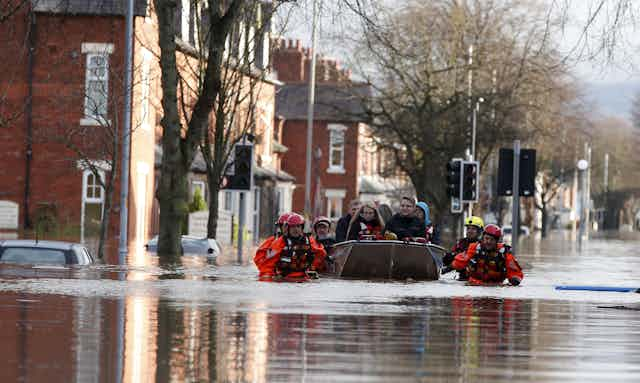More than 40,000 people were forced to leave their homes after Storm Desmond caused devastating floods and wreaked havoc in north-west England. Initial indications were that the storm may have caused the heaviest local daily rainfall on record in the UK. As much as £45m has been spent on flood defences in the region in the previous ten years and yet the rainfall still proved overwhelming. So what should we actually expect from flood defence measures in this kind of situation? And why do they sometimes fail?
We know that floods can and will happen. Yet we live and work and put our crucial societal infrastructure in places that could get flooded. Instead of keeping our entire society away from rivers and their floodplains, we accept flood risks because living in lowlands has benefits for society that outweigh the costs of flood damage. But knowing how much risk to take is a tricky business. And even when there is an overall benefit for society, the consequences for individuals can be devastating.
We also need to calculate risks when we build flood defences. We usually protect ourselves from some flood damage by building structures like flood walls and river or tidal barriers to keep rising waters away from populated areas, and storage reservoirs and canals to capture excess water and channel it away. But these structures are only designed to keep out waters from typical-sized floods. Bigger defences that could protect us from the largest possible floods, which may only happen once every 100 years, would be much more expensive to build and so we choose to accept this risk as less than the costs.
Balancing the costs and benefits
In the UK, the Environment Agency works with local communities to assess the trade off between the costs of flood protection measures, and the benefits of avoiding flood damage. We can estimate the lifetime benefits of different proposed flood protection structures in the face of typical-sized floods, as well as the results of doing nothing. On the other side of the ledger, we can also estimate the structures’ construction and maintenance costs.
In some cases, flood protection measures can be designed so that if they fail, they do the least damage possible, or at least avoid catastrophic damage. For example, a flood protection wall can be built so that if flood waters run over it they run into a park rather than residential streets or commercial premises. And secondary flood walls outside the main wall can redirect some of the overflow back towards the river channel.

The Environment Agency puts the highest priority on the projects with the largest benefits for the smallest costs. Deciding where that threshold should be set is a very important social decision, because it provides protection to some but not all parts of our communities. Communities and businesses need to be well-informed about the reasons for those thresholds, and their likely consequences.
We also protect ourselves from flood damage in other ways. Zoning rules prevent valuable assets such as houses and businesses being built where there is an exceptionally high flood risk. Through land management, we can choose to increase the amount of wooded land, which can reduce the impact of smaller floods. And flood forecasting alerts emergency services and helps communities rapidly move people and their portable valuables out of the way.
Always some risk
It’s important to realise that since flood protection measures never eliminate all the risks, there are always extra costs on some in society from exceptional events such as Storm Desmond, which produce very large floods that overwhelm protection measures. The costs of damage from these exceptional floods are difficult to estimate. Since these large floods have been rare in the past, our records of them are very limited, and we are not sure how often they will occur in the future or how much damage will they cause. We also know that the climate is changing, as are the risks of severe floods, and we are still quite uncertain about how this will affect extreme rainfall.
At the same time we know that it’s very hard to judge the risk from catastrophic events. For example, we are more likely to be afraid of catastrophic events such as nuclear radiation accidents or terrorist attacks, but do not worry so much about much larger total losses from smaller events that occur more often, such as floods.
Although the process of balancing costs against benefits seems clear and rational, choosing the best flood protection structure is not straightforward. Social attitudes to risk are complicated, and it’s difficult not to be emotionally involved if your home or livelihood are at risk.

